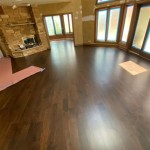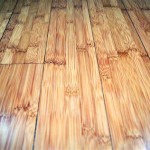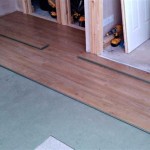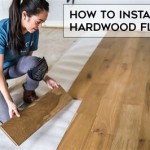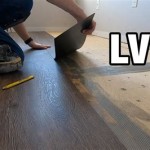Can Vinyl Plank Flooring Be Installed On Subfloor?
Vinyl plank flooring has emerged as a popular choice amongst homeowners and contractors alike due to its durability, water resistance, aesthetic appeal, and relative ease of installation. A key aspect of successful vinyl plank flooring installation, however, hinges on the suitability of the subfloor. The subfloor acts as the foundation upon which the vinyl plank flooring rests, and its condition directly impacts the longevity and performance of the finished floor. This article will delve into the considerations surrounding the installation of vinyl plank flooring on various types of subfloors, highlighting the necessary preparation techniques and potential issues that may arise.
Understanding the Subfloor Requirements for Vinyl Plank Flooring
Vinyl plank flooring, while adaptable, demands a specific set of characteristics from the subfloor to ensure a successful and lasting installation. The primary requirements include flatness, stability, cleanliness, and dryness. Any deviations from these criteria can lead to problems such as uneven flooring, plank separation, squeaking, and even premature wear.
Flatness: The subfloor should be as flat as possible. Ideally, it should have no more than 3/16 inch variation over a 10-foot span. This is crucial because vinyl plank flooring, particularly thinner options, will conform to the contours of the subfloor. Unevenness will translate into an uneven walking surface, which can be aesthetically unappealing and potentially create tripping hazards. Significant variations require leveling compounds or other corrective measures before installation.
Stability: A stable subfloor is essential to prevent movement that could compromise the integrity of the vinyl plank flooring. Instability can arise from loose boards, inadequate support, or underlying structural issues. Ensuring the subfloor is securely fastened and capable of bearing the intended load is a prerequisite for a successful installation. For example, if installing over a wood subfloor, ensure joists are adequately spaced and that the subfloor itself is properly attached to the joists.
Cleanliness: The subfloor must be thoroughly cleaned before vinyl plank flooring is installed. Dirt, debris, dust, and any existing adhesives can interfere with the adhesion of the planks (for glue-down installations) or create unevenness (for floating installations). A thorough sweeping or vacuuming, followed by wiping with a damp cloth, is often necessary. In some cases, specialized cleaning solutions may be required to remove stubborn residues.
Dryness: Moisture is a significant enemy of many flooring materials, including vinyl plank. Excessive moisture in the subfloor can lead to mold growth, warping, and adhesive failure. Before installation, the moisture content of the subfloor should be tested using a moisture meter. Acceptable moisture levels vary depending on the type of subfloor, but generally, wood subfloors should have a moisture content below 12%, and concrete subfloors should meet specific moisture vapor emission rates (MVER) or relative humidity (RH) levels determined by industry standards and the flooring manufacturer’s recommendations.
Subfloor Types and Preparation Techniques
Different types of subfloors require specific preparation techniques to ensure they meet the criteria outlined above. Common subfloor materials include plywood, oriented strand board (OSB), concrete, and existing resilient flooring. Each presents its own unique challenges and necessitates tailored preparation methods.
Plywood and OSB Subfloors: Plywood and OSB are common wood-based subfloor materials. When preparing these surfaces for vinyl plank flooring, several steps are crucial. First, inspect the subfloor for any loose or damaged boards. Replace any compromised sections to ensure a stable and even surface. Next, drive down any protruding nails or screws to prevent them from interfering with the flooring. Sand down any seams or high spots to create a smoother surface. Finally, clean the subfloor thoroughly to remove dust and debris.
Concrete Subfloors: Concrete subfloors require careful preparation due to their inherent porosity and potential for moisture issues. Begin by inspecting the concrete for cracks, holes, or other imperfections. Fill any cracks with a concrete patching compound approved for flooring applications. Level any uneven areas using a self-leveling concrete mixture. Allow the patching compound and leveling mixture to cure completely according to the manufacturer's instructions before proceeding. The most critical step is to test the concrete for moisture content. A moisture meter can be used to determine the moisture content, or a calcium chloride test can be performed to measure the moisture vapor emission rate. If the moisture levels are too high, a moisture barrier must be installed before the vinyl plank flooring.
Existing Resilient Flooring: In some cases, vinyl plank flooring can be installed over existing resilient flooring, such as sheet vinyl or linoleum. However, this is only advisable if the existing flooring is in good condition and adheres firmly to the subfloor. Loose or damaged areas must be repaired or removed. Clean the existing flooring thoroughly to remove any wax, polish, or other contaminants. It is generally not recommended to install vinyl plank flooring over multiple layers of existing flooring or over cushioned vinyl, as this can lead to instability and premature failure. Always consult the vinyl plank flooring manufacturer's recommendations regarding installation over existing resilient flooring.
Potential Problems and Considerations
Even with meticulous preparation, certain potential problems and considerations must be addressed to ensure a successful vinyl plank flooring installation. These include dealing with existing imperfections, addressing moisture issues, and selecting the appropriate type of vinyl plank flooring for the specific subfloor conditions.
Addressing Existing Imperfections: Regardless of the subfloor type, some imperfections are inevitable. Small cracks or minor unevenness can often be addressed with leveling compounds or underlayment. However, significant structural issues or extensive damage require more comprehensive repairs. Ignoring these imperfections can lead to unstable flooring, squeaking, and premature wear.
Addressing Moisture Issues: Moisture is a persistent threat to flooring installations. High moisture levels in the subfloor can lead to mold growth, warping, and adhesive failure. In addition to testing for moisture, it is essential to identify and address the source of the moisture. This may involve repairing leaks, improving ventilation, or installing a moisture barrier. Selecting a vinyl plank flooring product with a high degree of water resistance can also help mitigate the risks associated with moisture.
Selecting the Appropriate Vinyl Plank Flooring: Not all vinyl plank flooring products are created equal. The thickness, construction, and installation method can all impact the suitability of the flooring for a particular subfloor. Thicker planks tend to be more forgiving of minor imperfections in the subfloor. Glue-down installations require a smooth and level surface, while floating floors may tolerate slight variations. It is crucial to carefully review the manufacturer's recommendations and select a product that is appropriate for the specific subfloor conditions and intended use.
Proper subfloor preparation is not merely a preliminary step; it is an integral component of a successful vinyl plank flooring installation. By addressing the critical factors of flatness, stability, cleanliness, and dryness, and by employing the appropriate preparation techniques for the specific subfloor type, homeowners and contractors can ensure a durable, aesthetically pleasing, and long-lasting flooring solution.

How To Prep Wood Subfloor For Luxury Vinyl Plank Flooring Beginners Fix High And Low Spots

Lvp Flooring Installation Over Concrete Subfloor Full Instructional Builds By Maz Flooret

How To Install Glue Down Luxury Vinyl Plank Flooring On Osb Sub Floor

Choosing Underlayment For Vinyl Plank Flooring Your Ultimate Guide Jona Panel S Inc

Can You Install Luxury Vinyl Plank Flooring Without Underlayment

Installing Vinyl Plank Flooring Vapor Barrier On Wood Sub Floor

Preparing Your Sub Floor For Luxury Vinyl Plank Flooring Floors Paws

How To Prepare A Concrete Floor For Vinyl Flooring Parrys

Preparing To Install Luxury Vinyl Flooring Floors For Paws

Do You Need An Underlayment For Vinyl Plank Flooring
See Also

